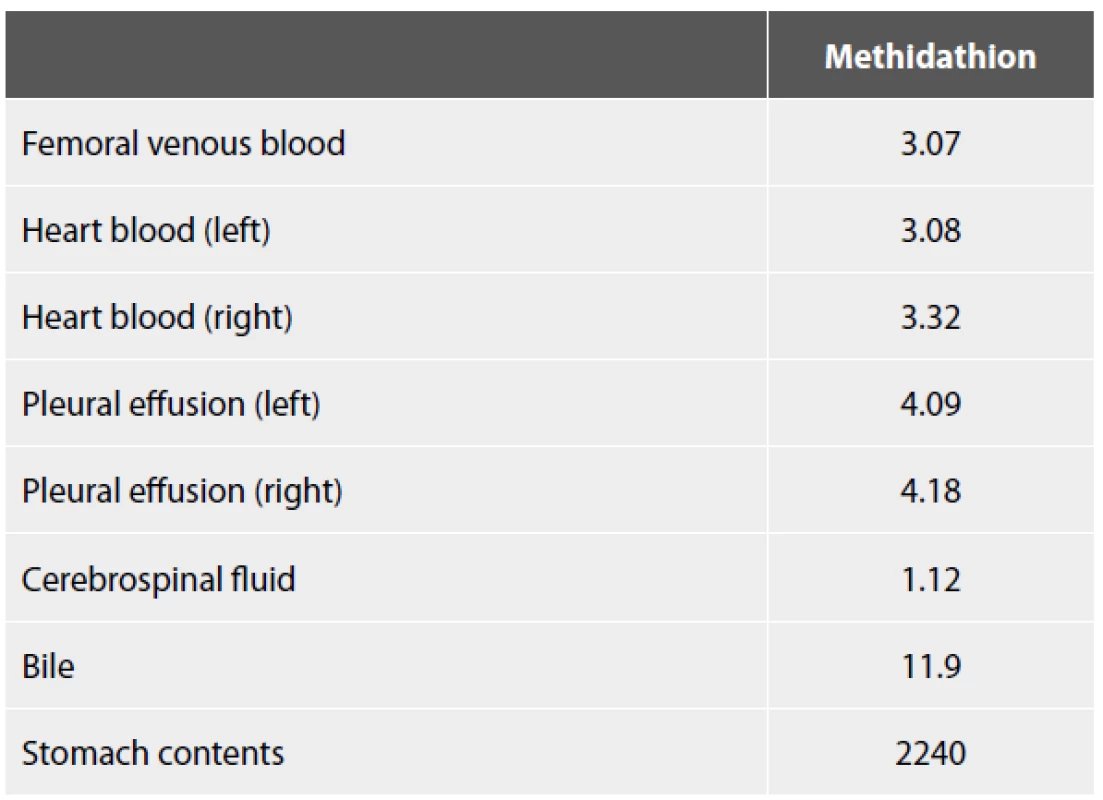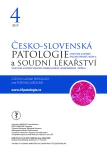Medicolegal implication of an autopsy case of methidathion ingestion
Soudně lékařský závěr pitvy zemřelého po požití methidathionu
Prezentujeme případ pitvy po požití methidathionu, organothiofosfátového pesticidu. Více než osmdesátiletý muž byl nalezen v bezvědomí ve svém domě. Zemřel přibližně deset hodin po přijetí do nemocnice, navzdory intenzivní léčbě.
Soudní pitva neodhalila žádné zevní poranění. Pro screening těkavých látek byla použita plynová chromatografie s hmotnostní spektrometrií. V žaludečním obsahu byl zjištěn xylen a ethylbenzen. Přítomnost těchto látek ukazuje na požití průmyslových chemikálií, jakými jsou například insekticidy či pesticidy. Následná toxikologická analýza byla provedena pomocí kapalinové chromatografie s hmotnostní spektrometrií. V krvi odebrané z femorální žíly byla stanovena koncetrace methidathionu 3.07 µg/ml, v žaludečním obsahu koncentrace 2240 µg/ml. Koncentrace methidathionu v periferní krvi byla tedy v rozmezí popisovaném u smrtelných případů otrav (1.8-8.33 µg/ml). Ačkoliv koncentrace methidathionu v žaludku byla poměrně vysoká, téměř stejná koncentrace byla stanovena mezi srdcem a periferní krví. Vysvětlením může být, že během hospitalizace nebyl proveden výplach žaludku a pacient přežíval 10 hodin v nemocnici. Závěrem pitvy bylo požití insekticidu methidathionu. Na základě toxikokinetiky byla odhadnuta vstřebaná dávka 8,9 g methidathionu, v žaludku se nacházelo 0.34 g methidathionu. Celková požitá dávka byla tedy minimálně 9.2 g methidathionu.
Klíčová slova:
methidathion – insecticide – otrava – smrtelná
Authors:
Tanaka Naoko 1; Kinoshita Hiroshi 1; Kumihashi Mitsuru 1; Jamal Mostofa 1; Ito Asuka 1; Tsutsui Kunihiko 2; Kimura Shoji 1; Ameno Kiyoshi 1
Authors‘ workplace:
Department of Forensic Medicine, Faculty of Medicine, Kagawa University, Miki, Kita, Kagawa, Japan
1; Department of Health Sciences, Faculty of Medicine, Kagawa University, Miki, Kita, Kagawa, Japan
2
Published in:
Soud Lék., 64, 2019, No. 4, p. 42-43
Category:
Overview
We present an autopsy case involving ingestion of methidathion, an organothiophosphate pesticide. A headspace gas chromatography mass spectrometry system was used for screening of volatile compounds. Subsequent toxicological analysis was performed using liquid chromatography tandem mass spectrometry. Xylene and ethylbenzene were detected in stomach contents. We also identified methidathion at concentrations of 3.07 and 2240 µg/ml in femoral venous blood and stomach contents, respectively. We concluded that the victim ingested methidathion insecticide, with an estimated dose of at least 9.2 g.
Keywords:
overdose – methidathion – insecticide – fatal
Methidathion is an organothiophosphate in wide use as a pesticide (1). Four cases of fatal methidathion ingestion have been reported (2-4). Here we report a fatal case of methidathion ingestion, and discuss the distribution of this chemical in body fluids.
CASE REPORT
A male in his eighties (height, 161 cm; weight, 58 kg) was found unconsciousness in his house and transported to hospital, where he received intensive treatment. His stomach contents emitted a solvent-like odor, and miosis was observed on admission. The clinical diagnosis was acute organophosphate poisoning. He died approximately 10 h after admission, despite intensive therapy. Medico-legal autopsy revealed no evidence of external injury. The heart weighed 455 g, and the left and right lungs weighed 899 and 554 g, respectively, with severe congestion. The brain weighed 1427 g, and was slightly edematous. No findings suggestive of natural disease were observed. Pleural effusions were collected from the thoracic cavity (left, 40 ml; right, 30 ml). Stomach contents comprised approximately 150 ml of brownish liquid, containing food residue emitting a slight solvent-like odor. No residual urine was present in the bladder. Samples of blood (femoral vein, left and right heart chambers), pleural effusion (left and right thoracic cavity), cerebrospinal fluid, bile and stomach contents were collected for toxicological examinations.
METHODS
A headspace gas chromatography mass spectrometry (HS-GC/MS) system (QP-2010 Plus; Shimadzu, Kyoto, Japan) was used to screen for volatile compounds (5-7). Quantitation of ethanol was performed using headspace gas chromatography. Subsequent toxicological analysis using liquid chromatography tandem mass spectrometry (LC-MS/MS) was performed as described previously (8). Briefly, liquid chromatography separations were carried out using ekspertTM ultraLC 100-XL (Eksigent part of Sciex, Framingham, MA). An L-column2 ODS (1.5 mm × 150 mm, 5.0 µm particle size; Chemicals Evaluation and Research Institutes, Tokyo, Japan) was used with a mobile phase of solvent A (5% methanol containing 10 mM ammonium formate) and solvent B (95% methanol containing 10 mM ammonium formate) with a flow rate of 0.1 mL/min. A QTrap® 4500 tandem mass spectrometer (Sciex) was used to obtain the mass spectra.
RESULTS AND DISCUSSION
In the present case, HS-GC/MS analysis identified isomers of xylene and ethylbenzene from the stomach contents and blood, but no ethanol was detected. Since xylene and ethylbenzene are used as solvents, the presence of those agents suggest ingestion of agricultural chemicals, such as insecticides and pesticides (5-7,9,10). Subsequent toxicological analysis using LC-MS/MS identified methidathion in blood, stomach contents and other specimens. Table 1 shows the quantitation of methidathion in each sample. The peripheral blood concentration of methidathion in the present case was within the range reported from fatal cases (1.8-8.33 µg/ml) (2-4).

Based on the autopsy findings and results of subsequent examinations, including toxicological examination, we concluded that the cause of death was methidathion poisoning. Although the concentration in stomach contents (2.24 mg/ml) was markedly higher than that in blood, the concentration in stomach contents in the present case was lower than that in previous reports (3,4), which may be due to the intensive treatments provided in hospital. A large difference between heart and peripheral blood concentrations of methidathion was also observed in a previous report (4), which may be due to the aspiration of stomach contents into the lung. Although a relatively high concentration of methidathion was detected in the stomach contents, almost the same concentration was observed between the heart and peripheral blood in the present case. This may be due to the fact that stomach contents were not aspirated and the patient survived for 10 h following admission to hospital.
Methidathion concentration in bile was relatively higher than those in other specimens, indicating that bile may be one of the major routes of excretion for organophosphates. As the concentrations of a drug or chemical in pleural effusion and bile are rarely related to the ranges of blood concentration (11-13), those samples should be used for qualitative evaluations in cases where clean blood samples are unavailable (11).
Using toxicokinetic parameters of methidathion, such as distribution volume (Vd) (50 L/kg) (1), the victim’s body weight and femoral blood levels, we estimated the total amount of methidathion ingested. The estimated dose of methidathion using toxicokinetic parameters was 8.9 g, and the amount of methidathion remaining in the stomach (150 ml) was approximately 0.34 g. The total amount ingested was thus at least 9.2 g of methidathion based on the toxicokinetic estimation.
CONFLICT OF INTEREST
The authors declare that there is no conflict of interest regarding the publication of this paper.
Dr. H. Kinoshita
Department of Forensic Medicine, Faculty of Medicine, Kagawa University
1750-1, Miki, Kita, Kagawa 761-0793, Japan
tel: +81-87-891-2140; fax: +81-87-891-2141
e-mail: kinochin@med.kagawa-u.ac.jp
Received: February 7, 2019
Accepted: July 22, 2019
Sources
- Baselt RC. Disposition of toxic drugs and chemicals in man. 8th ed. Foster City, CA: Biochemical Publications; 2008.
- Tsatsakis AM, Aguridakis P, Michalodimitrakis MN, et al. Experiences with acute organophosphate poisonings in Crete. Vet Hum Toxicol 1996; 38 : 101-107.
- Arao T, Fuke C, Takaesu H, et al. A case of fatal trichlorfon and methidathion poisoning. Leg Med 2002; 4 : 182-186.
- Takayasu T, Ishida Y, Nosaka M, et al. High concentration of methidathion detected in a fatal case of organophosphate-poisoning. Leg Med 2012; 14 : 263-266.
- Kinoshita H, Tanaka N, Jamal M, et al. Xylene; a useful marker for agricultural products ingestion. Soud Lek 2013; 58 : 59-60.
- Tanaka N, Kinoshita H, Takakura A, et al. Combination of energy-dispersive X-ray fluorescence spectrometry (EDX) and head-space gas chromatography mass spectrometry (HS-GC/MS) is a useful screening tool for stomach contents. Rom J Leg Med 2015; 23 : 43-44.
- Kinoshita H, Tanaka N, Takakura A, et al. Analysis of stomach contents by head-space gas chromatography/mass spectrometry to screen for ingestion of insecticide. Revista e Mjekësisë Ligjore Shqiptare (Review of Albanian Legal Medicine) 2015; 11 : 85-89.
- Kinoshita H, Tanaka N, Takakura A, et al. Flunitrazepam in stomach contents may be a good indicator of its massive ingestion. Rom J Legal Med 2017; 25 : 193-195.
- Yamazaki M, Terada M, Kuroki H, et al. Pesticide poisoning initially suspected as a natural death. J Forensic Sci 2001; 46 : 165-170.
- Kinoshita H, Ameno K, Ameno S, et al. A case of burning with fenitrothion ingestion. Res Pract Forens Med 2001; 44 : 155-159.
- Knight B. Forensic pathology. 2nd ed. London: Arnold; 1996.
- Tanaka N, Kinoshita H, Kuse A, et al. Forensic toxicological implications of pleural effusion; an autopsy case of drug overdose. Soud Lek 2012; 57 : 48-50.
- Bévalot F, Cartiser N, Bottinelli, et al. State of the art in bile analysis in forensic toxicology. Forensic Sci Int 2016; 259 : 133-154.
Labels
Anatomical pathology Forensic medical examiner ToxicologyArticle was published in
Forensic Medicine

2019 Issue 4
Most read in this issue
- MUDr. Josef Pleskot sedmdesátiletý
- Medicolegal implication of an autopsy case of methidathion ingestion
- Dopravní úrazy 2019
- XX. Rozmaričovy soudně lékařské dny
